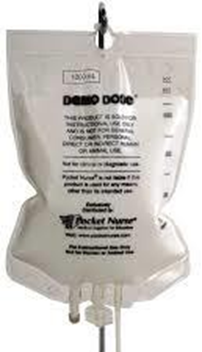A nurse is caring for a client who weighs 190 lb and is receiving total parenteral nutrition. If the RDA of protein is 0.8 g/kg of body weight, how many grams of protein should the client receive daily? (Round the answer to the nearest whole number. Use a leading zero if it applies. Do not use a trailing zero.)
The Correct Answer is ["69"]
To calculate the daily protein requirement for the client, first convert the weight from pounds to kilograms, knowing that 1 kilogram equals 2.2 pounds.
The client's weight in kilograms is 190 lb divided by 2.2, which equals approximately
86.36 kg.
Then, multiply the weight in kilograms by the recommended dietary allowance (RDA) of protein, which is 0.8 g/kg. So, 86.36 kg multiplied by 0.8 g/kg equals about
69.09 g. Rounding to the nearest whole number, the client should receive 69 grams of protein daily.

Nursing Test Bank
Naxlex Comprehensive Predictor Exams
Related Questions
Correct Answer is B
Explanation
A) While wearing an N95 respirator may be necessary for certain infections, it is not a routine precaution for clients in protective isolation.
B) Ensuring the client's room has positive-pressure airflow helps prevent the entry of airborne pathogens into the room, reducing the risk of infection for the immunocompromised client.
C) Using disposable plates and utensils helps reduce the risk of cross-contamination and infection transmission but is not directly related to airborne infection control.
D) Monitoring the client's temperature is important for assessing for signs of infection, but it does not directly prevent infection transmission in the same way as positive-pressure airflow.
Correct Answer is ["A","B","C","D","E"]
Explanation
A) The client's pain level decreased from 7 to 5 after receiving nitroglycerin. This decrease indicates improvement in the client's condition.
B) The client’s respiratory rate decreased from 24/min to 22/min.
C) The client’s heart rate decreased from 120/min to 100/min.
D) Initially, the client's oxygen saturation was 93% on room air, which decreased to 89%. However, after receiving oxygen at 2 L/min via nasal cannula it improved to 92%.
E) The blood pressure decreased from 176/82 to 110/62.
F) Only one echocardiogram result showing myocardial infarction was provided.
G) Only one reading of I&O was provided showing an output of 32 mL, hence difficult to determine whether there was an improvement.
Whether you are a student looking to ace your exams or a practicing nurse seeking to enhance your expertise , our nursing education contents will empower you with the confidence and competence to make a difference in the lives of patients and become a respected leader in the healthcare field.
Visit Naxlex, invest in your future and unlock endless possibilities with our unparalleled nursing education contents today
Report Wrong Answer on the Current Question
Do you disagree with the answer? If yes, what is your expected answer? Explain.
Kindly be descriptive with the issue you are facing.
